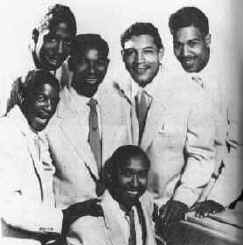
The Chords
A form of R&B based harmony vocalizing using phonetic or nonsense syllables (like a repeated "doo-wop") for rhythm and intricate harmonic arrangements
What Is Doo Wop?

The Chords
A form of R&B based harmony vocalizing using phonetic or
nonsense syllables (like a repeated "doo-wop")
for rhythm and intricate harmonic arrangements
|
|
To be considered doo wop a song must fit into all five of the below, with minor exceptions:
Vocal Group Harmony - A wide range of voices (usually bass to high tenor or falsetto) must be combine in vocal harmony or more commonly run underneath the lead vocalist. Usually the second tenor and baritone blend together as one sound, with high tenor often falsetto running over the lead and the bass underneath.
Wide Range of Voice Parts (lead, first
tenor (falsetto), second tenor, baritone, bass.
A. Lead Voice - The lead voice is usually a tenor
(castrato) such as Frankie Lymon, but a bass will lead in
part of the song. Bass leads or more often found
in uptempo songs, while falsettos are more often
found in ballads. Melisma, a gospel vocal technique in
which syllables are elongated to fit the meter of
the song was used in some regularity by the lead
voice in early doo wop ballads.
B. Bass - There is almost always a distinct bass
part. The bass part often provides the introduction
and/or punctuates the song between choruses. The
bass typically runs under the lead voice, either as part
of the back ground harmony, or a voice separate from the
lead or harmony. Occasionally the bass will provide
a talking bridge in the middle of the song.
C. Falsetto - Falsetto parts are often found
in doo wop, most commonly at the end of the song, as part
of the lead voice's fade out. Especially in ballads,
the bass will echo the lead, be part of the background
harmony or "run above" the background harmony.
Nonsense Syllables - There is a liberal and frequent use of nonsense syllables with no meaning such as doo wop, bum buh-buh bum bum, lit-lit-lit-lit. Bass and harmony frequently use this device. They tended to be more restrained, simple and somber when used in ballads
Simple Beat and Light Instrumentation
Beat and Instrumentation - background beats are simple
and heavy, drumming uncomplicated and anything but
subtle.
A. Beat - doo
wop started on the street corners with finger snaps and
hand claps providing the beat.
B.
Instrumentation - Originating on the street, voices were
musical instruments and so it was when it moved to the
recording studios. Instruments played little part in doo
wop.
Simple Music and Lyrics - Most doo wop songs are written with simple melodies, often with four chord progressions. Doo Wop lyrics tend to be repetitive, simple, dialectical, hackneyed and ungrammatical.